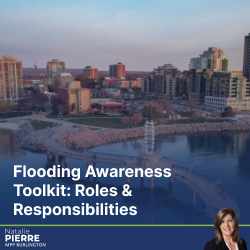
Flooding Roles & Responsibilities
Flooding in Ontario is typically caused by melting snow, ice jams and heavy rain and can impact both urban and rural areas. Many organizations play important roles in managing and responding to flood emergencies.
Local flood response and sandbags
Municipalities handle on-the-ground flood response and may request provincial assistance.
The Ministry of Natural Resources (MNR) may provide public safety services to support Indigenous
communities and unincorporated/unorganized areas with flooding emergencies, evacuations and
sandbags. For more information, contact your local MNR work centre.
If you live within an Indigenous community, support for flooding emergencies may be a shared
responsibility between Indigenous Services Canada (ISC), Emergency Management Ontario and your local MNR work centre.
Local flood monitoring support
Conservation authorities and MNR monitor watershed and weather conditions to assess flood
potential and issue flood messages. These flood notifications inform the public of developing unsafe river and lake conditions.
Communities and areas not serviced by conservation authorities can get flood information from their local MNR work centre.
Provincial flood monitoring
MNR works in partnership with many organizations including conservation authorities and
Environment and Climate Change Canada for flood management in Ontario.
MNR’s Surface Water Monitoring Centre is the source of current flood and drought information in
Ontario. The centre provides information about potential flood and low water risks.
Disaster relief
The Ministry of Municipal Affairs and Housing provides funding to Ontarians and municipalities
impacted by a natural disaster. Learn more.
Emergency coordination
The Treasury Board Secretariat coordinates emergency management across Ontario and is
responsible for the Provincial Emergency Operations Centre. Learn more.
Indigenous Communities
Indigenous Services Canada (ISC) helps ensure emergency preparedness and response plans are in place, as well as funding eligible flood mitigation preparedness and response measures.
ISC administers the Emergency Management Assistance Program (EMAP) to reimburse on-reserve
emergency management activities, including flood mitigation, preparedness, response and recovery.
Wastewater and stormwater
The Ministry of the Environment, Conservation and Parks (MECP) oversees wastewater and
stormwater management.
Infrastructure funding
The Ministry of Infrastructure (MOI) provides funding to communities through various federal provincial infrastructure programs and the Ontario Community Infrastructure Fund.
Great Lakes water management
The International Joint Commission has jurisdiction over cases involving shared boundary waters
between Canada and the United States, including the Great Lakes.
Dam management
MNR supports dam safety and compliance and approves the construction and alteration of dams
under the Lakes and Rivers Improvement Act. Dams throughout Ontario are owned and operated by a variety of organizations. Learn more.
Water management in the Ottawa River Basin
The Ottawa River Regulation Planning Board was established to ensure the integrated water
management of 13 principal reservoirs of the Ottawa River Basin as part of an agreement between
Canada, Quebec and Ontario.
QUICK FACTS
Flooding can be caused by melting snow, ice jams and heavy rain. It can happen anytime,
anywhere, with flash floods sometimes striking with little or no warning.
Know who to contact
• Your municipality is responsible for on-the-ground flood response.
• Your local conservation authority is responsible for local flood messaging.
• If your community is not serviced by a conservation authority, your local Ministry of
Natural Resources work centre provides flood messaging and information.
• Monitor the latest flood conditions at ontario.ca/FloodForecast.
Always be flood-ready
To be prepared for any emergency, create a 72-hour emergency preparedness plan and kit.
Indoors
• Put insurance policies, medical records and other important documents in a safe place
• Store belongings in sealed bins
• Keep chemicals away from flood-prone areas
• Install check valves in sewer drains
• Test sump pumps regularly and have a backup system
• Seal basement windows and ground-level doors
Outdoors
• Extend downspouts at least 2 metres from your home to move water away
• Remove debris that could be dangerous during floods
• Secure outdoor furniture and items around piers, docks or boathouses
• Regularly maintain water drainage systems
During a flood
Take immediate action: Monitor local news. Evacuate if instructed by emergency officials.
If flooded: Leave immediately if your property is flooding and electricity is on. Move to
higher ground, avoid roads near water and do not walk or drive through moving water.
After a flood
Before returning home: Check with your local municipality for public health and safety
information.
Take safety precautions: Don’t use electrical items or utilities until deemed safe. Avoid
contact with flood water and report damaged utility lines.
Property damage: If your property has been damaged, you may need permits to rebuild.
You may also be eligible for provincial assistance.
Stay informed: The Ministry of Natural Resources’ Surface Water Monitoring Centre is the
source of current flood and drought information in Ontario. We help protect you by providing
information about potential flood and low water risks in your area, so that you can be
prepared.
Learn more about what to do before, during and after a flood: ontario.ca/Flood
